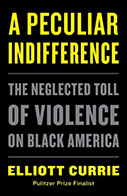A Peculiar Indifference: The Neglected Toll Of Violence On Black America

Author: Elliott Currie
Publisher: New York: Metropolitan Books, 2020. 288p.
Reviewer: Mary Welek Atwell | September 2021
The last year has seen an examination and a reckoning about racial injustice in the United States, and especially in the criminal justice system. Some have noted that Americans are more attentive to racial issues than at any time since the civil rights movement of the 1960s. Certainly there has been an outpouring of studies, both academic and journalistic, on the subject. The two books considered here represent a big picture examination of violence as a form of racial inequality and social injustice (Currie), and a focused case study of the ways in which discrimination has reduced the meaning of citizenship for Black residents of the greater St. Louis area (Gordon). Both delve into the historical policies and practices that account for the enduring racial disparities that show up in many facets of life—from issues with housing and public services, to the glaring inequalities in the criminal justice system.
Currie begins his book with a general presentation of the extent of violence in the United States as it impacts the lives of African Americans, and the “peculiar indifference” of white Americans to the implications of that problem. Although W.E.B. DuBois first authored the phrase over a hundred years ago, Currie argues that the unresponsiveness to the human suffering of people of color continues into the twenty-first century. He cites a number of reasons: the poor, especially those from minority groups, are regarded as dispensable in a global economy; the communities that suffer most are those with the least political influence; and, America’s “punitive and austere culture” has directed social resources toward incarceration and retribution. He asserts that racial disparities in the quality of life, including housing and health care, are not the result of abstract or random forces, but rather they are caused by many conscious decisions that impoverish some while others enjoy extraordinary privilege.
Currie devotes one chapter to a statistical picture of violence as it affects communities of color. The numbers are familiar, yet still appalling, to all who study criminal justice. Another chapter examines the effects of that violence on families and individuals, especially the impact on how children develop, including such impacts as a loss of faith in the future, inhibited cognitive development, PTSD, and even a “psychic numbing” where some learn to accept violence as a fact of life. It is hard to reconcile these dire descriptions of the way violence affects the lives and futures of the innocent with the chronic indifference of the larger society.
In an especially powerful chapter, Currie discusses “pioneers” who provided insights by illuminating the “mechanisms by which structural oppression translates into personal and communal harm.” He delves into the writings of DuBois, Gunnar Myrdal, and Kenneth Clark, among others, where he finds their critiques of American society totally relevant to the contemporary environment. All denied that the prevalence of violence as a serious problem in Black communities was related to any racial proclivity, but asserted instead that violence was a predictable outcome of white racial oppression and the deprivation and restricted opportunities imposed by white institutions. Those institutions—economic, social, legal, and political—would need to be transformed for the “plague” of violence to be ended.
Contemporary commentators echo many of the same themes, including the notion that violence is not only a result of social and economic injustice, but also that it stems from a lack of opportunities to challenge the injustice in more direct and productive ways. Residential patterns exacerbate these conditions. Researchers have argued that spatial segregation (the racial separation of neighborhoods) is a result of the deliberate discriminatory policies throughout the last century that limited the options for housing available to African Americans, and created cities divided by race. Neighborhood violence is higher in the more segregated cities where minority areas are characterized by poverty, joblessness, and hopeless futures. Colin Gordon’s book on St. Louis illustrates that theme.
Currie proposes several remedies. He talks of a national commitment to full employment for all, and the rebuilding of the public sector as necessary social investments. He also discusses a rethinking of the criminal justice system that would involve a turn away from a reactive and punitive approach to something focused on harm reduction and peacebuilding. Most are familiar progressive suggestions, but it is encouraging that such ideas are reflected in policy proposals from the current presidential administration.
There is nothing new in the analysis that violence in Black communities is the result of persistent social and economic disadvantage. What may be new is that others outside those communities have been forced to pay attention, not because of careful arguments mustered by scholars like Elliott Currie, but because of the shocking news reports of violence by police against Black citizens following the murder of George Floyd. Such events have made “peculiar indifference” generally unsustainable as many more Americans have become attuned to the calls to rectify systemic injustice toward communities of color.
The “Citizen” Brown referenced in Gordon’s title is Michael Brown, the young man shot by a police officer in Ferguson, a suburb of St. Louis, Missouri, in 2014. The killing of Brown touched off the Black Lives Matter movement. It focused attention on the frequent deaths of African Americans at the hands of the police, and forced many people out of their ignorance and indifference to systemic racial injustice. Gordon’s original and valuable approach is to examine the multiple structural barriers to full citizenship and its benefits that have been denied to Michael Brown and millions other people of color. His study is based on only one city and its suburbs, but the analysis could be replicated in many urban areas.
I will admit to having a special interest in Citizen Brown as I spent the first twenty-five years of my life in St. Louis. It is shameful to admit that one could grow up there as an educated person who subscribed to liberal views yet remained generally unaware of the local conditions that made for white privilege and structural racism. Gordon traces the ways in which the definition of citizenship at the local level is based on the inclusion of some and the exclusion of others. The benefits go to those who meet the standards: being employed; paying taxes; owning a home; being a consumer. These are the very requirements that the racial discrimination built into American institutions have denied to people of color.
The St. Louis municipal area, and particularly St. Louis County with its history of fragmented local governments and its rigid patterns of segregation, brings the concept of hierarchical citizenship into focus. The fragmentation of local governments allowed some to “hoard” the opportunities that were denied to others in less affluent areas. Schools, roads, policing, and other public services vary greatly among the suburbs and neighborhoods as each depends on its own (segregated) tax base. What I had missed as a local resident was the extent to which these differences in social resources were the consequence, not only of economic status, but also the result of generations of policies meant to reinforce racial exclusion.
This is the story that needs to be told—locally and nationally—if we are ever to understand the injustice that underlies the frustration and anger of Black Americans. The murders of Michael Brown, Brionna Taylor, Eric Garner, Elijah McClain, Philandro Castile, Tamir Rice, Terrence Crutcher, George Floyd, and others have shone a bright light on unequal enforcement of the law. Books such as Currie’s and Gordon’s offer both deeper understanding of the roots of racial injustice and inspiration to address reform.
Reviewed by Mary Welek Atwell, Professor Emerita of Criminal Justice, Radford University.


